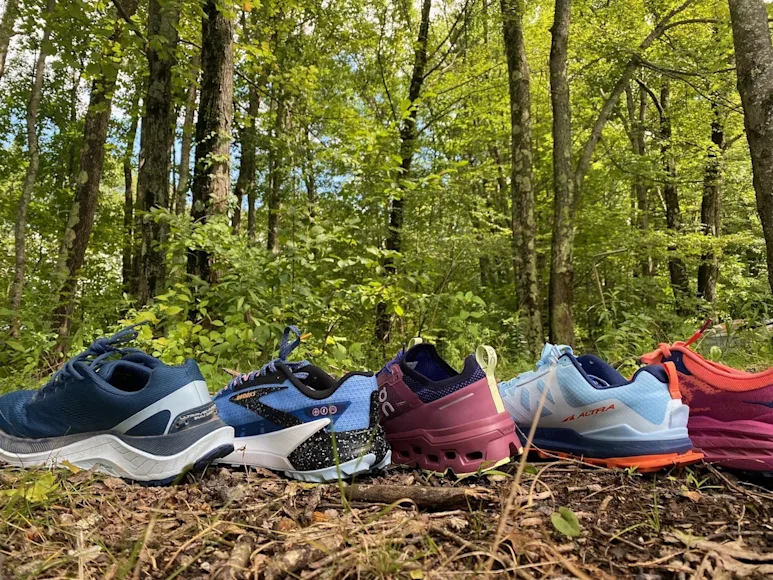_We may earn revenue from the products available on this page and participate in affiliate programs. Learn more ›
_
Best for Men
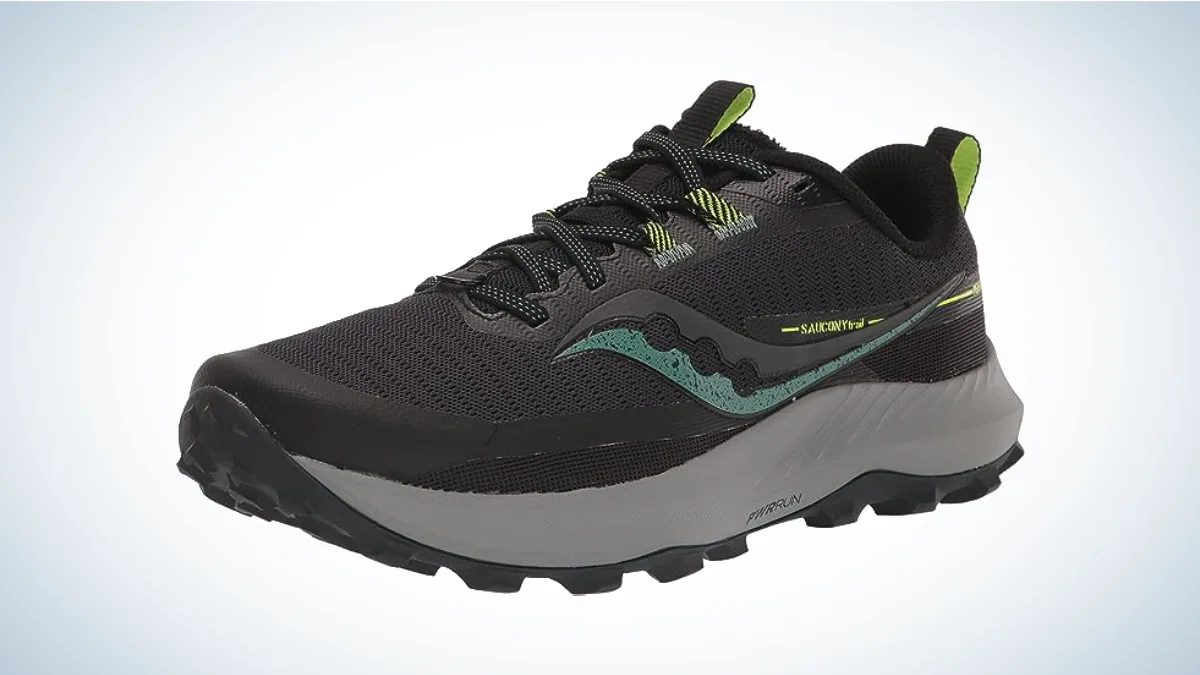
Saucony Peregrine 13
Best for Women
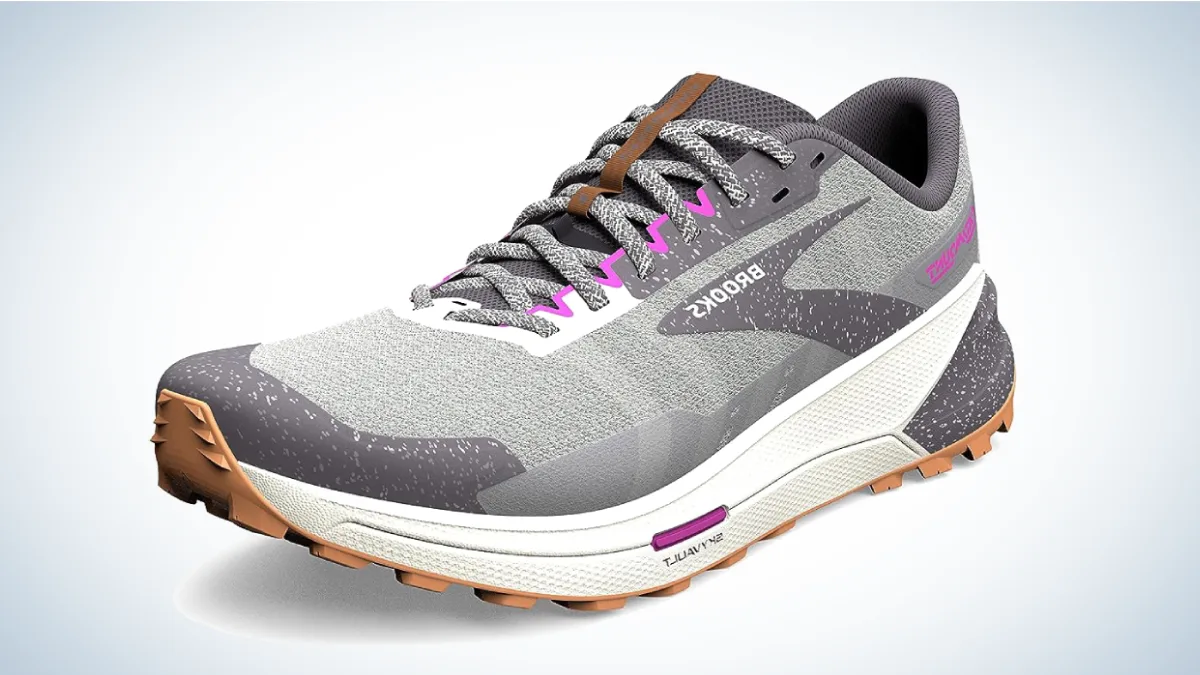
Brooks Catamount 2
Best Cushioned
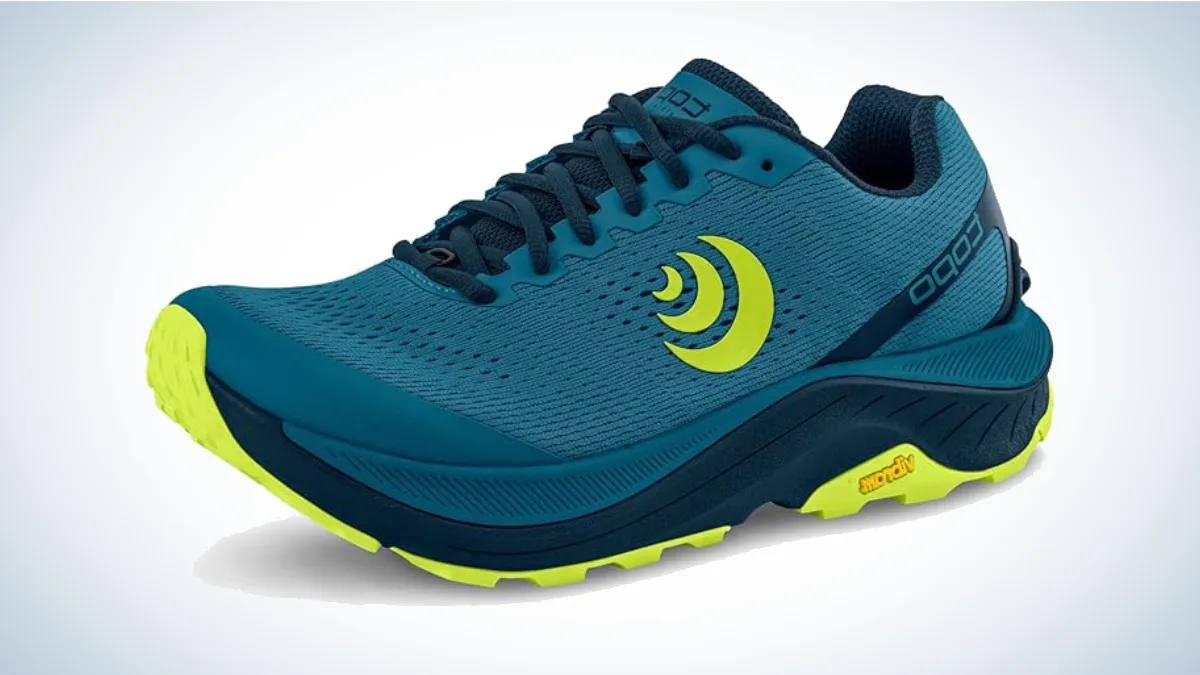
Topo Ultraventure 3
The world of trail running shoes is complicated. With so many technical performance features and debates about the best style out there, it’s easy to feel overwhelmed by your options. Do you want high drop or zero drop, high stack or low stack, stable or flexible—it’s tough to navigate.
We laced up and took to the trails to help you choose the perfect shoe, whether you’re a seasoned trail enthusiast or a newcomer. After evaluating pairs from top brands like Hoka, Brooks, and Altra on innovation, comfort, and performance, we narrowed down our favorites. As you embark into the exhilarating world of uphills and ultras, these are the best trail running shoes for your next run.
Best for Men: Saucony Peregrine 13
Best for Women: Brooks Catamount 2
Best for Hiking: Hoka Speedgoat 5
Best Cushioned: Topo Ultraventure 3
Best for Wide Feet: Altra Lone Peak 7
Best for Narrow Feet: On Cloudultra 2
Best Lightweight: Merrell MTL Skyfire 2
How We Picked the Best Trail Running Shoes

We tested shoes from some of the most popular footwear brands. Lindsey Lapointe
To provide accurate and unbiased recommendations for the best trail running shoes, I devised a multi-stage selection process. I started my research by gathering insights from dedicated trail runners. I interviewed them on their preferences and identified features they value in their trail running shoes. I then proceeded with the following steps:
Market Research: I consulted with leading trail running shoe brands and did thorough market research to identify the newest and most innovative offerings available.
Trail Testing: I put each shoe through extensive field testing on a variety of terrains ranging from technical trails in the White Mountains to moderate paths and flat rail trails.
Multi-Dimensional Analysis: Using my own experience as both a road and trail runner, I meticulously analyzed each shoe on a set of crucial parameters: fit, comfort, flexibility, traction, and durability. Additionally, I had the privilege of consulting with high-performance trail runners for specific categories, ensuring that our selections for “Best for Men” and “Best Lightweight” categories were endorsed by experts in the field.
While finding the perfect trail running shoe always comes down to personal preference and fit, I’m confident the methodology employed will help narrow your own list and hopefully find the best trail running shoe for you.
Best Trail Running Shoes: Reviews and Recommendations
Best for Men: Saucony Peregrine 13
Best for Men

Specs
Weight Per Shoe: 9.2 oz
Heel-to-Toe Drop: 4 mm
Cushion: Medium
Pros
Lightweight
Flexible
Has a rock guard for added protection
Cons
Lacks support
Designed with a focus on foot protection, flexibility, and durability, the Saucony Peregrine 13
is our choice for the best men’s trail running shoe. For starters, the shoe features a robust rock plate and a reinforced foot bumper, shielding your foot from rough terrain and unexpected obstacles. In terms of durability, the Peregrine 13 has a rugged tread and sturdy mesh construction. Our testers reported it performed well on hills and through a range of terrain. The mesh and sole held up over many miles of use which makes it a great value.
This shoe has a lower stack height than some of its competitors, which adds to its flexibility and responsiveness on the trail. We found the Saucony shoe comfortable with a true-to-size fit. It has plenty of room in the toe box as well as a cushioned hold on the back. Bonus: If you’re a runner looking for waterproof trail running shoes, you’ll love that it also comes in a Gore-Tex version.
Best for Women: Brooks Catamount 2
Best for Women

Specs
Weight Per Shoe: 8.6 oz
Heel-to-Toe Drop: 6 mm
Cushion: Medium
Pros
Supportive
Durable
Rock plate and toe cap protection
Cons
Not for technical trails
The new Brooks Catamount 2
performed well throughout our testing, earning our choice for the best women’s trail running shoes. It fits true to size and is very comfortable right out of the box. The slightly wider toe box and secure heel provided ample support throughout my test runs, and the shoe itself feels very durable. It features a robust rock plate that shields your foot from jagged rocks and roots while elevating the uphill efficiency. Adding to that, the toe cap and mud guard work in unison to safeguard against the threats of rocky terrain.
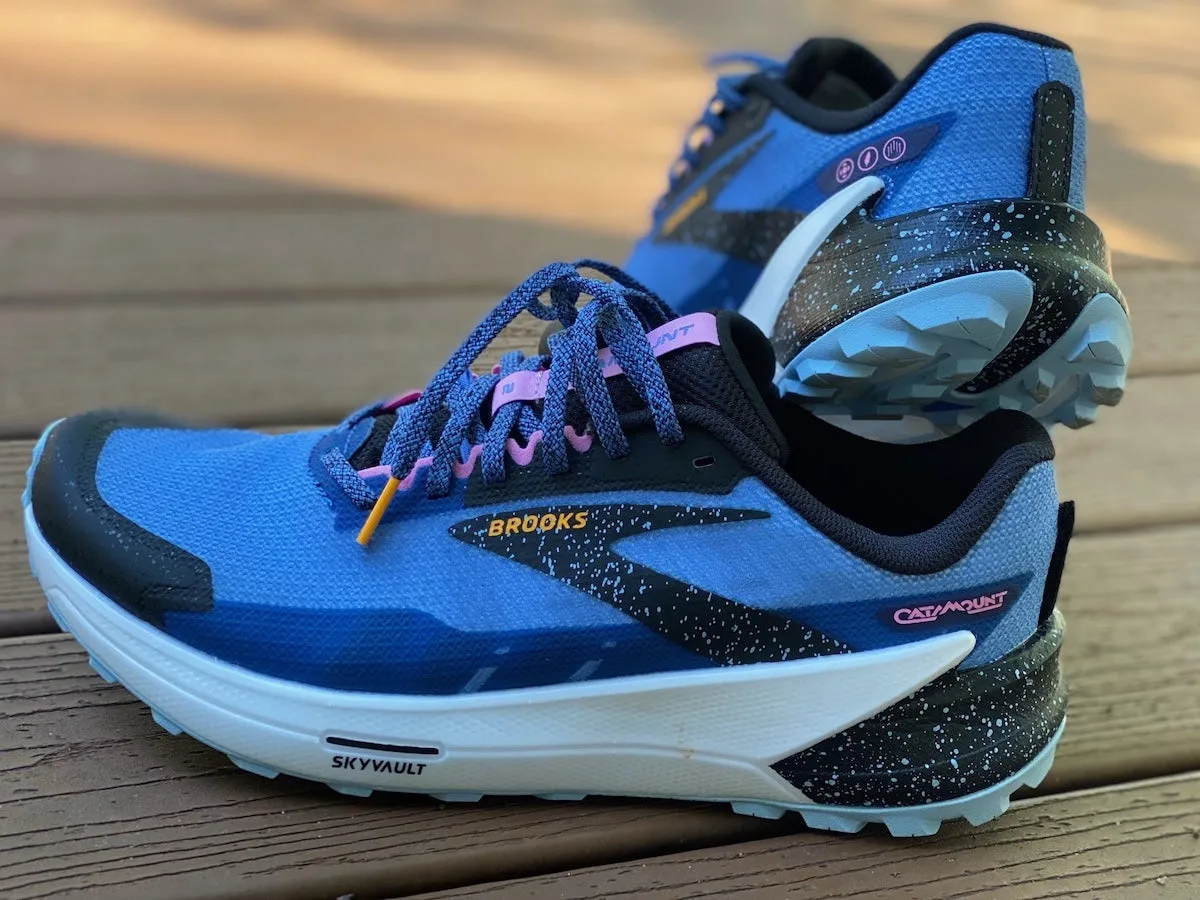
With bright colors and a modern design, these shoes look as good as they function, in my opinion. Lindsey Lapointe
This Brooks trail running shoe falls into the medium flexibility category, which I like because it offers so much protection and cushioning in return. It’s also compatible with gaiters, which is great for mud or sandy runs. As for traction, it strikes a good balance of reliability and agility.
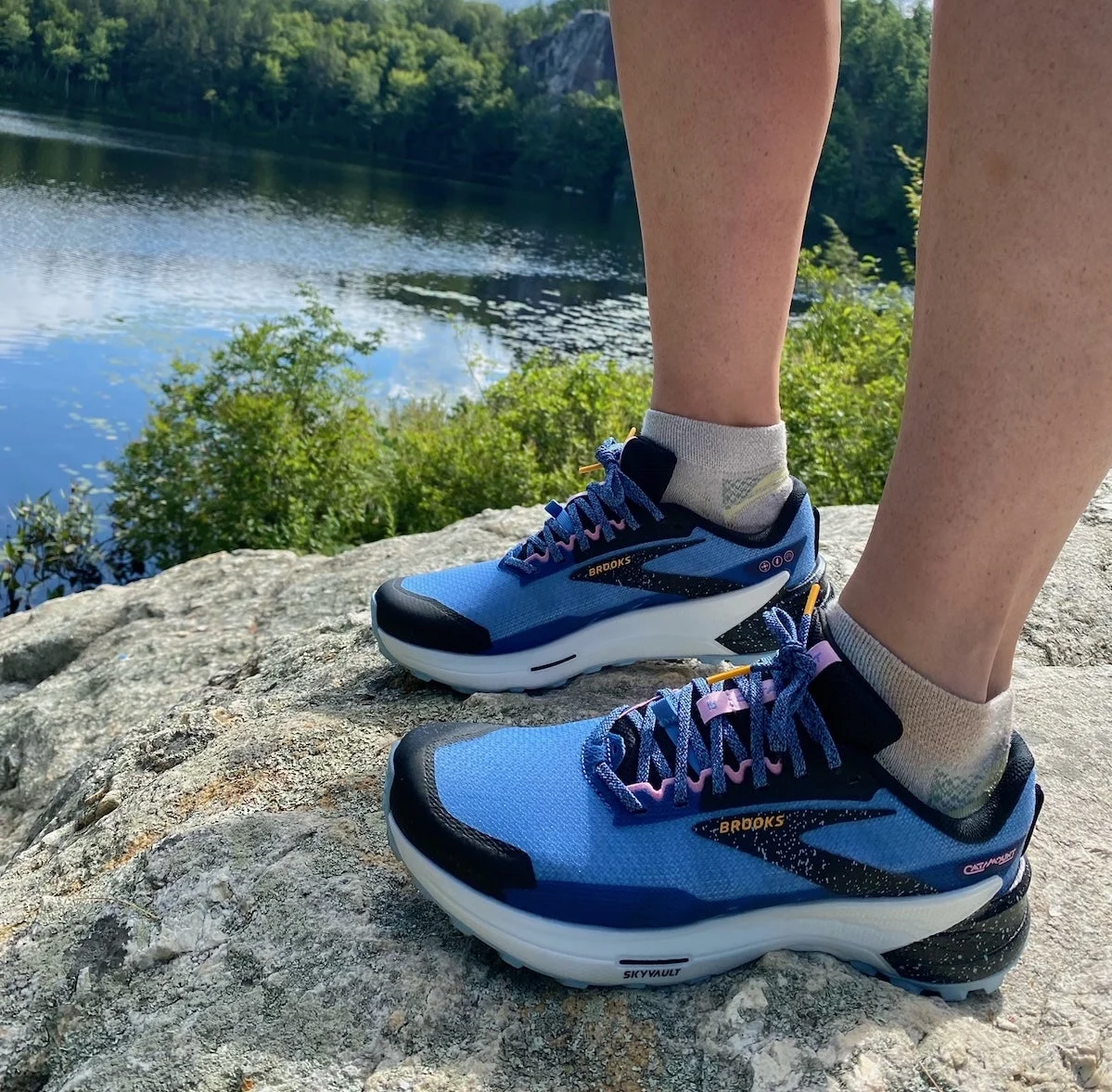
I was pleasantly surprised by the protection these shoes provided on the trail. Lindsey Lapointe
I was able to try the Catamount 2 as both a running shoe and a hiking shoe. It handled varied terrain well, even climbing up wet granite slab during testing. On a more superficial level, I personally love the element of style with its range of vibrant colors. These shoes will bring enjoyment and comfort to female trailblazers.
Best for Hiking: Hoka Speedgoat 5
Best for Hiking
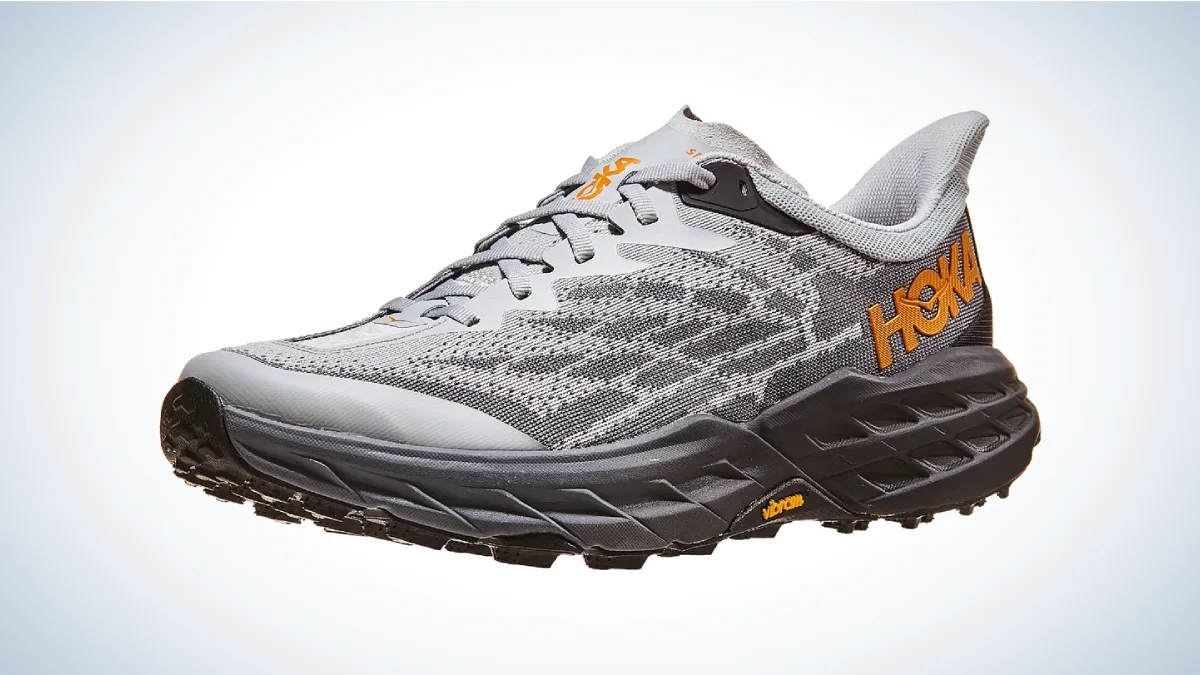
Specs
Weight Per Shoe: 10.3 oz
Heel-to-Toe Drop: 4 mm
Cushion: Maximum
Pros
Comfortable
Lightweight and breathable
Many personalized options in sizing and features
Cons
Lacks support
The comfortable fit and light weight of the Hoka Speedgoat 5
make them as great as trail runners as they are hiking shoes
. Designed to conquer diverse terrain, this shoe effortlessly navigated over trails with strong traction from the Vibram Megagrip outsole during our testing. While its substantial cushioning and tall stack may reduce its responsiveness and flexibility compared to some alternatives, this very aspect makes it an ideal companion for all-day hikes and runs, providing essential cushioning for your feet and knees.
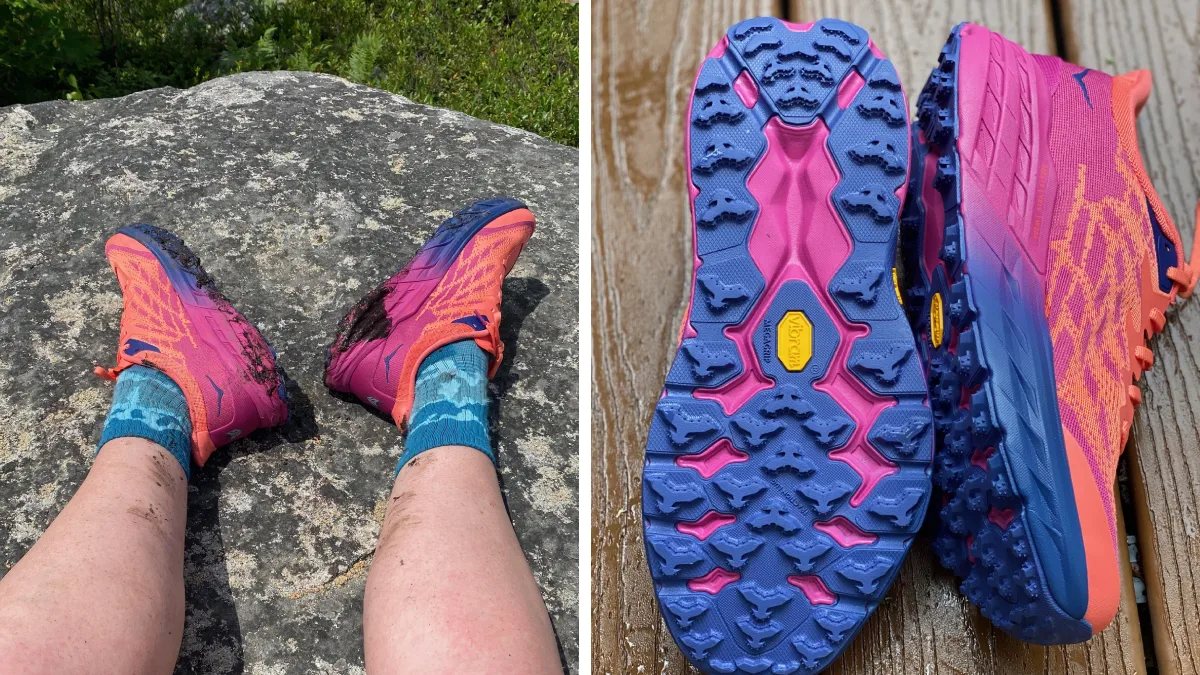
The Hoka Speedgoat is a blend of trail running shoe and hiking shoe. Lindsey Lapointe
I found these shoes to fit true to size, and they have a variety of sizing and style options, including wide fit, waterproof, winter tread, and even a high top. The Hoka trail running shoes encapsulates the perfect blend of comfort, versatility, and tread. They’re well worth investing in—you can wear them for almost any outdoor activity.
Best Cushioned: Topo Ultraventure 3
Best Cushioned

Specs
Weight Per Shoe: 10.2 oz
Heel-to-Toe Drop: 5 mm
Cushion: Maximum
Pros
Cushioned with 35 mm stack height
Wide toe box
Gaiter compatible
Cons
Traction not for harsh terrain
trail running shoe is the perfect pick if you’re looking for cushioning and comfort on the trail. With a generous 35 mm stack height, it boasts remarkable cushioning while retaining its featherlight composition. Flexibility remains a strong suit, ensuring a natural stride without compromise, even in the absence of a rock plate.
I’d also argue that this was the most comfortable shoe I tested out of the box. Topo’s commitment to a true fit shines through, accommodating wide feet and promoting toe splaying with its roomy toe box. The breathable mesh provided a snug and secure grip on my midfoot and heel while I ran.
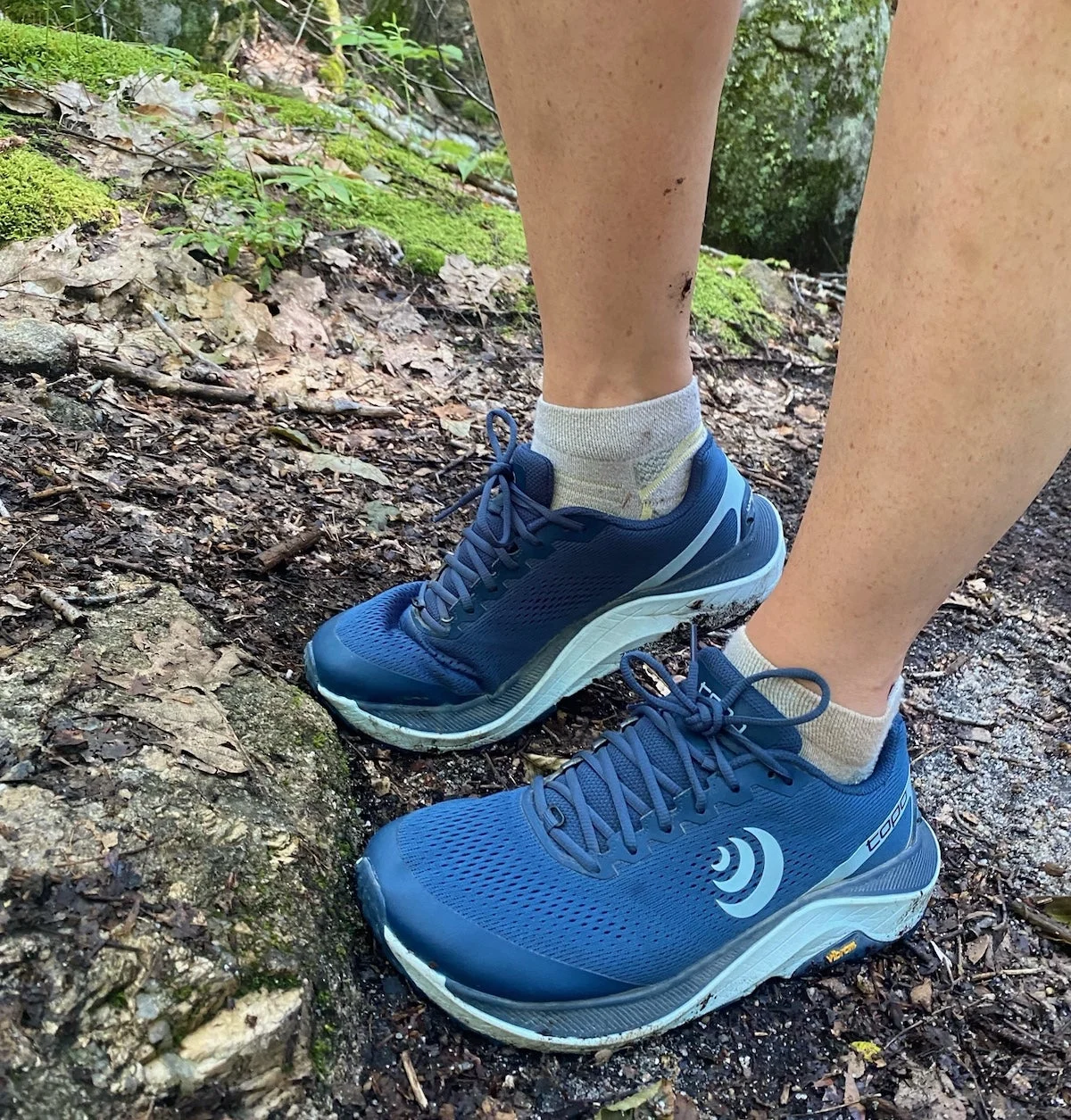
I wore these Topo shoes for hours on end with zero aches or pains. Lindsey Lapointe
Although it was my favorite shoe for comfort and cushioning, it’s worth noting that the outsole is best suited for mild to moderate trails. I didn’t trust the lower lugs on harsh terrain and mountain running. The Topo Ultraventure 3 redefines cushioning, providing a blend of support, comfort, and flexibility—perfect for the long-distance runner.
Best for Wide Feet: Altra Lone Peak 7
Best for Wide Feet

Specs
Weight Per Shoe: 11 oz
Heel-to-Toe Drop: 0 mm
Cushion: Medium
Pros
Wide toe box
Flexibility
Comfortable
Cons
Lack of foot protection
trail running shoe is a versatile option in the trail running realm and one of the best lightweight hiking shoes
, according to our experts. It’s also garnered a devoted following among thru-hikers, due to its reliable traction and inherent flexibility.
The shoe’s wide toe box is a boon for those with wide feet and a preference for toe spaying on a run. I really liked the moderate cushioning that provides reliable comfort even through hundreds of miles of trail. And the zero-drop design—which is one of my favorite features—encourages a natural stride.
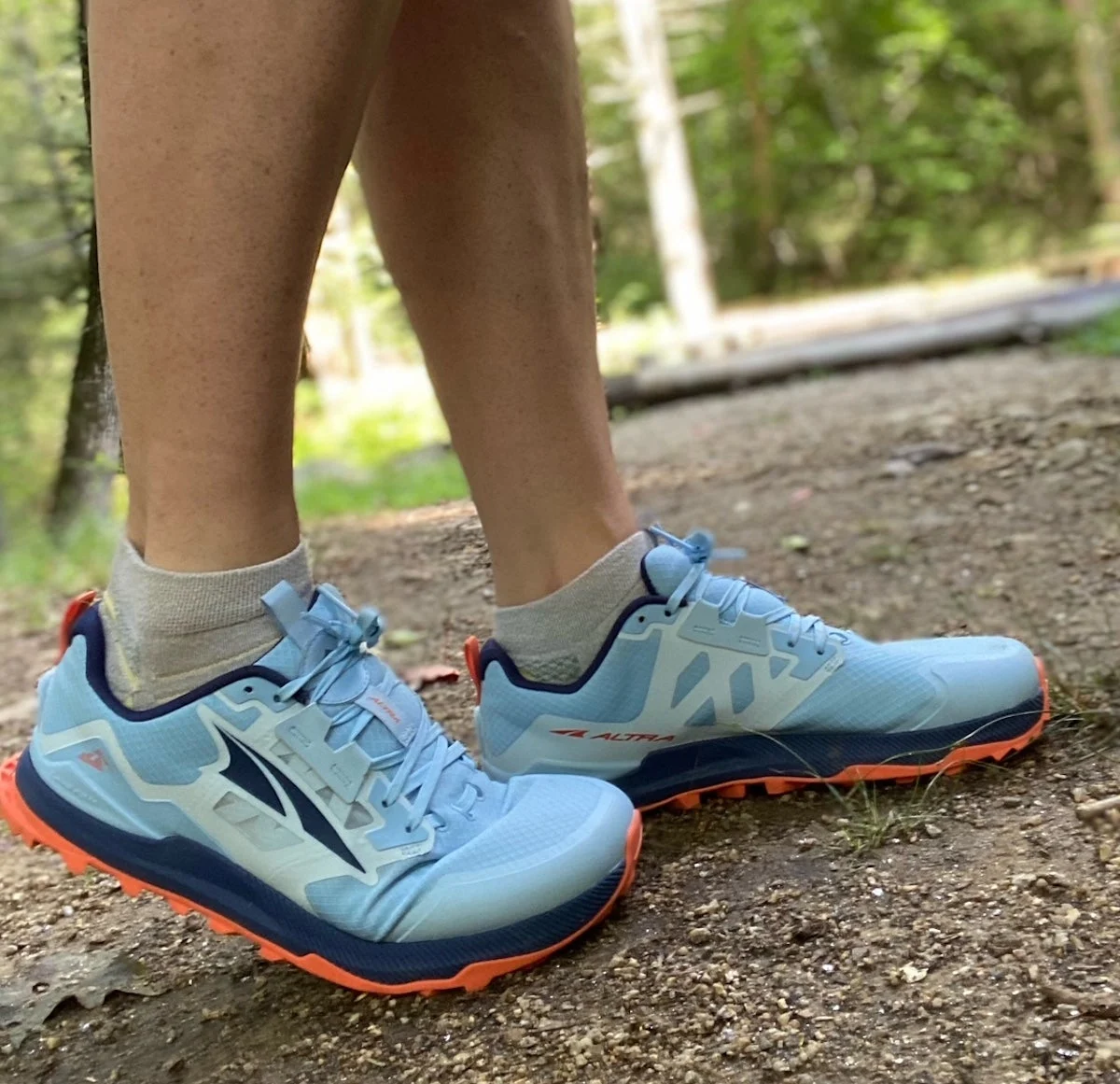
I was impressed with the flexibility of the Altra Lone Peaks. Lindsey Lapointe
Testing the Lone Peaks was an enjoyable experience—they’re comfortable, responsive, and well-ventilated. I found them to be a great companion on a long trail run. However, the Altra trail running shoes have an extra wide toe box that might not align with the preferences of runners with average or narrow feet. In addition to the wide box, I found this shoe to run large, so I recommend trying it on ahead of purchase, since it’s possible you’ll need to size it down. Despite this limitation, it deserves the accolades of providing a perfect fit for a set group of runners.
Best for Narrow Feet: On Cloudultra 2
Best for Narrow Feet

Specs
Weight Per Shoe: 10.2 oz
Heel-to-Toe Drop: 6 mm
Cushion: Maximum
Pros
Comfortable
No tongue – sock-like fit
Cushioned
Cons
Runs small
The On Cloudultra 2
was a fun shoe to test and a great pick for those looking for a snug fit and/or narrow foot shoe. The upper is made from stretchy knitted 100% recycled polyester that slips on like a sock. I loved this style—particularly because it means you don’t have to mess with a tongue. Over the sock-like layer is a breathable, protective mesh. This lightweight design not only ensures comfort, but also simplified the process of slipping on the Cloudultra without a fuss.
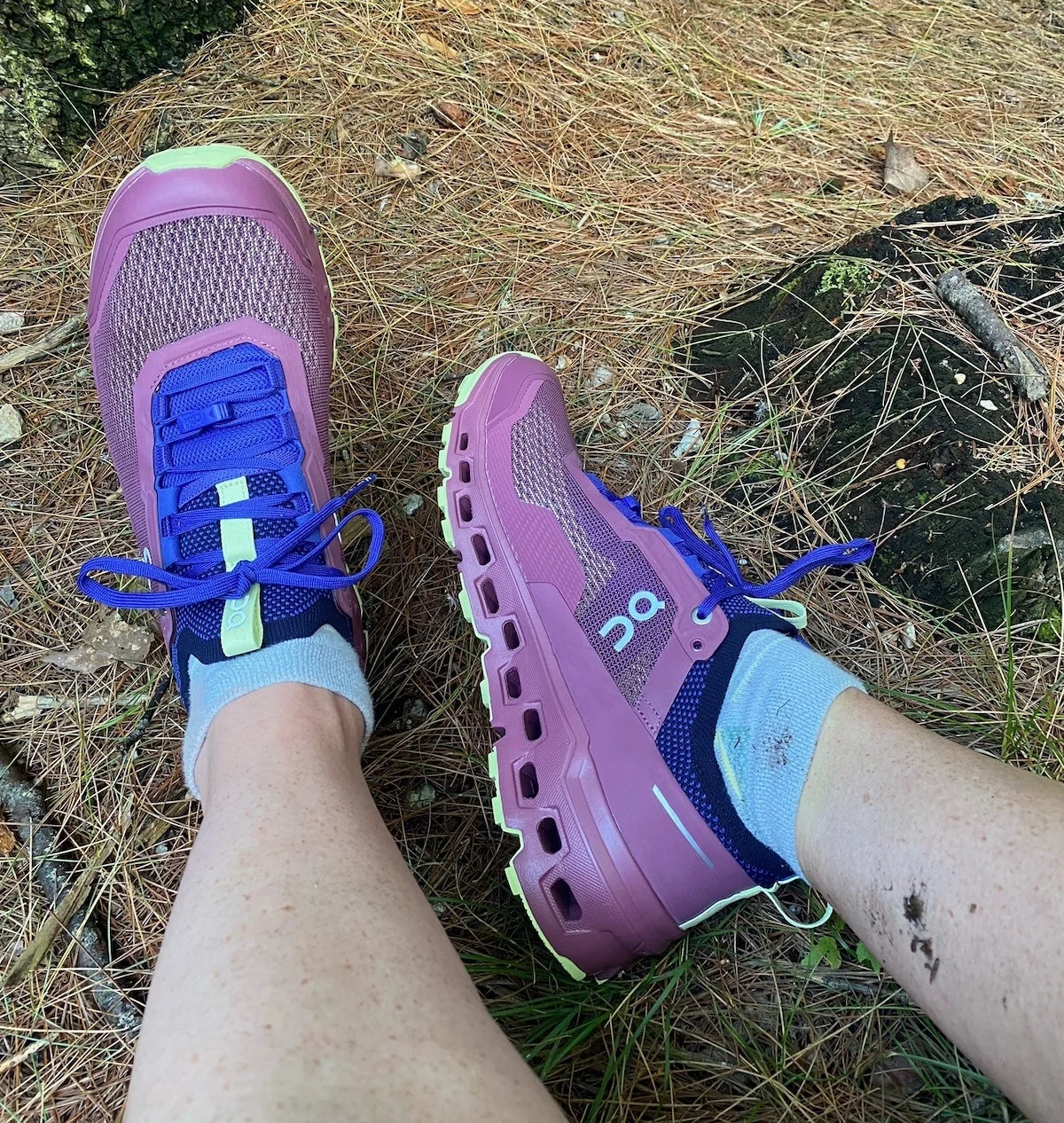
The Cloudultra is lightweight yet plenty supportive for long runs on the trail. Lindsey Lapointe
In contrast to many of its competitors that flaunt wide toe boxes, this shoe’s slightly narrower toe box provides a refreshing respite for those in search of a snugger fit. It’s important to note that while individuals with narrower feet will rejoice, others might consider sizing up by a half size to find their ideal fit.
The Cloudultra 2 had solid grip on mild to moderate trails, even though my personal preference might sway toward a more chevron-shaped lug design. Don’t let this minor quibble deter you—the CloudTech super foam delivers an astonishingly comfortable experience while safeguarding your joints, particularly on unforgiving surfaces. I found the balance of cushioning and firmness to strike a harmonious chord. Overall, this is a well-designed trail running shoe that delivers stability, comfort, and style to your trail run.
Best Lightweight: Merrell MTL Skyfire 2
Best Lightweight
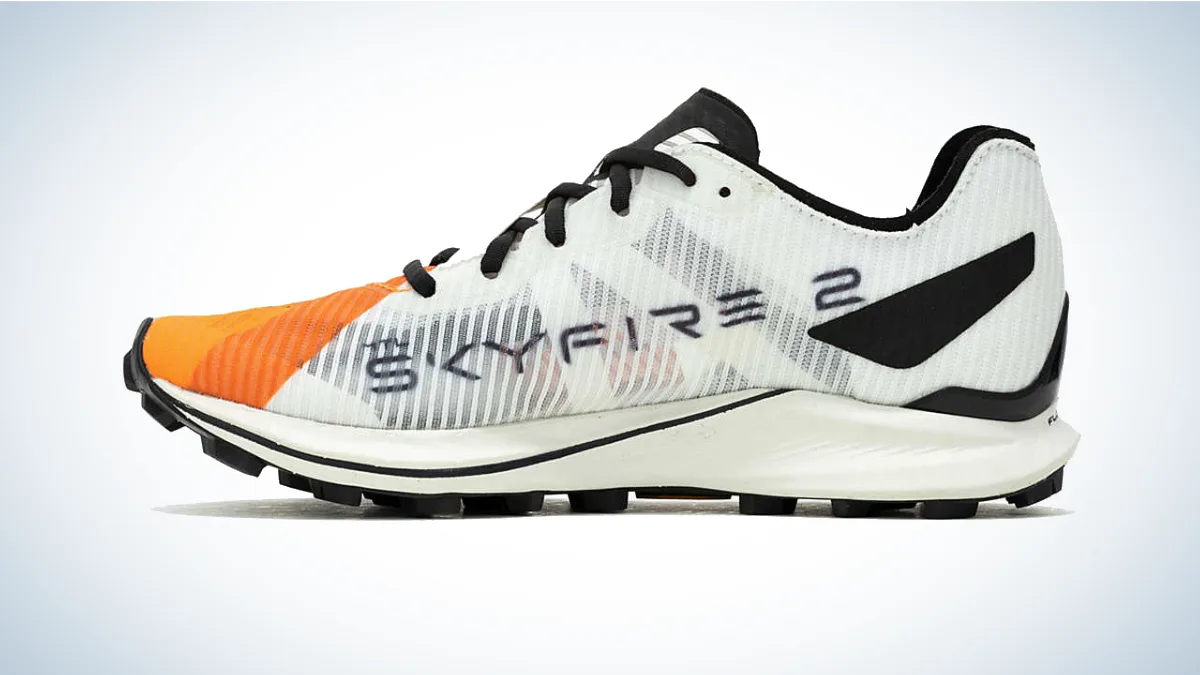
Specs
Weight Per Shoe: 6.88 oz
Heel-to-Toe Drop: 6 mm
Cushion: Moderate
Pros
Ultralight
Excellent traction
Comfortable
Cons
Expensive
After all of my testing, the Merrell MTL Skyfire 2
was by and far the obvious choice for the best lightweight trail running shoe. Tailored to elite runners and racers seeking peak performance, this shoe is the lightest available (or at least that I could find). Starting with fit, it’s tailored to the average foot, although it leans towards a more traditional narrow toe box, providing a snug and secure feel. The traction was excellent thanks to the solid lugs on the Vibram outsole that were particularly impressive on hill climbs and challenging terrain.
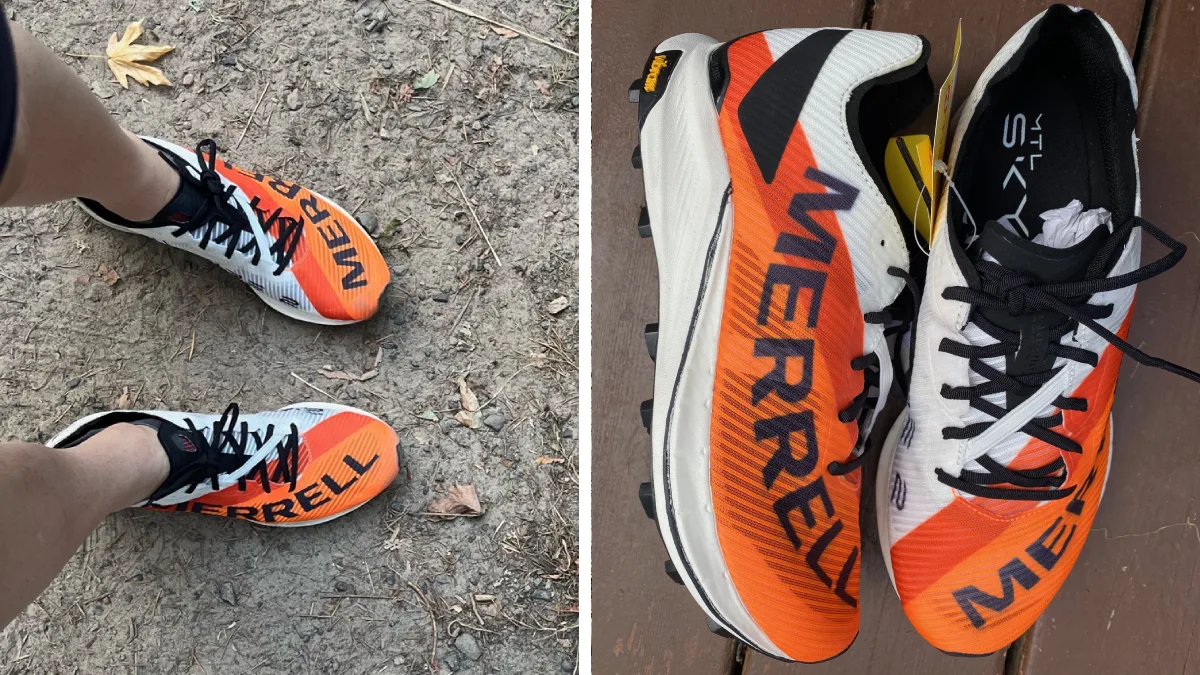
This Merrell trail running shoe is probably the lightest one you can buy right now. Lindsey Lapointe
Comfort was also surprisingly excellent considering its ultralight frame. An EVA foam footbed adds cushioning while the plate and foam midsole provides a comfortable blend of rigidity and stability that makes for a responsive ride. Lastly, the MTL Skyfire 2 is built for the long haul with a breathable, quick-drying, and impressively durable body. However, it’s important to note that the price point aligns with its premium quality, making it an investment in performance.
What to Consider When Choosing Trail Running Shoes
Before purchasing trail running shoes, it’s essential to do a little research and ensure you’re getting a pair right for your needs and preferences. Here’s what to consider:
Fit and Comfort
A proper fit is crucial. Make sure the shoe is comfortably snug without feeling too tight or too loose. Consider the width of the shoe and how it aligns with your foot shape.
Support and Cushioning
Depending on your preferences and running style, decide on what level of cushioning you need. Maximum comfort shoes (like the Hoka Speedgoat
) can provide relief for knee and hip joints. However, they can also sacrifice the feel of a flexible and responsive shoe so they’re best if you’re looking for running shoes for long distance.
Protection
Look for features like toe guards, rock plates, and durable mesh to protect your feet. If you plan to use a trail runner gaiter on your runs, choose a shoe that is gaiter compatible.
Drop Height
Most shoe brands will report out the heel-to-toe drop. Traditional sneakers usually have a relatively high drop of 8 mm or more, which provides cushioning if you strike the path with your heel. However, some runners prefer a low- or zero-drop shoe, which is harder on the Achilles but encourages a more natural stride.
Traction and Trail Type
Assess the type of trails you’ll be running on. Different traction patterns are designed for various terrains, such as rocky, muddy, technical, or packed trails. Choose an outsole with lugs that match your frequented trail type.
Lastly, before purchasing, it’s essential to try on the shoe. Consider your personal running style, preferences, and past experiences with different shoes. It’s easy to fall into hype about certain shoe types and brands. Stick with your gut—or your foot in this case—and pick a comfortable shoe for you.
FAQs
Q: Is it okay to use trail running shoes on the road?
Using trail running shoes on the road is acceptable, but it’s worth considering the impact on their performance. Trail running shoes are designed for natural surface—like dirt and grass—not man-made ones like asphalt. The tread on the outsole is made with raised rubber patterns called lugs, which provide traction on uneven surfaces.
While road running won’t cause harm to you or the shoes, the continuous abrasion against the pavement might wear down the lugs at a faster rate and reduce their effectiveness on trails. If you plan on frequently running on both road and trail, you might want to opt for a more versatile shoe that strikes a balance between the two terrains.
Q: What’s the difference between trail running shoes and normal shoes?
The main difference between trail running shoes and normal shoes is the environment they are designed for. Trail running shoes are specifically engineered to handle rugged terrain, featuring deeper and more aggressive outsole lugs for improved traction on uneven surfaces. They have many of the features of trail hiking shoes or hiking boots, like rock plates in the midsole to protect feet from sharp objects as well as reinforced toe caps, and durable uppers for added protection.
Q: When should I replace my trail running shoes?
You should consider replacing your trail running shoes when you notice significant wear and tear. A general guideline is to replace them every 300 to 500 miles of running, but this can vary based on factors like your running style, body weight, and the terrain you run on. If you start experiencing discomfort, reduced cushioning, or decrease in traction, it’s a good indication that your shoes have reached their limit.
I recommend regularly inspecting your shoes for signs and wear and monitoring how they feel during runs. This way, you can determine the right time for replacement to ensure optimal performance and injury prevention.
Best Trail Running Shoes: Final Thoughts
Best for Men: Saucony Peregrine 13
Best for Women: Brooks Catamount 2
Best for Hiking: Hoka Speedgoat 5
Best Cushioned: Topo Ultraventure 3
Best for Wide Feet: Altra Lone Peak 7
Best for Narrow Feet: On Cloudultra 2
Best Lightweight: Merrell MTL Skyfire 2
Trail running is a great way to experience nature while enhancing cardiovascular fitness. To ensure you’re getting the most out of the experience, choose one of the best trail running shoes that provides the support you need and the comfort you want. This way, you’ll be sure to find joy while running trails in the wild.
Why Trust Us
For more than 125 years, Field & Stream has been providing readers with honest and authentic coverage of outdoor gear. Our writers and editors eat, sleep, and breathe the outdoors, and that passion comes through in our product reviews. You can count on F&S to keep you up to date on the best new gear. And when we write about a product—whether it’s a bass lure or a backpack—we cover the good and the bad, so you know exactly what to expect before you decide to make a purchase.

